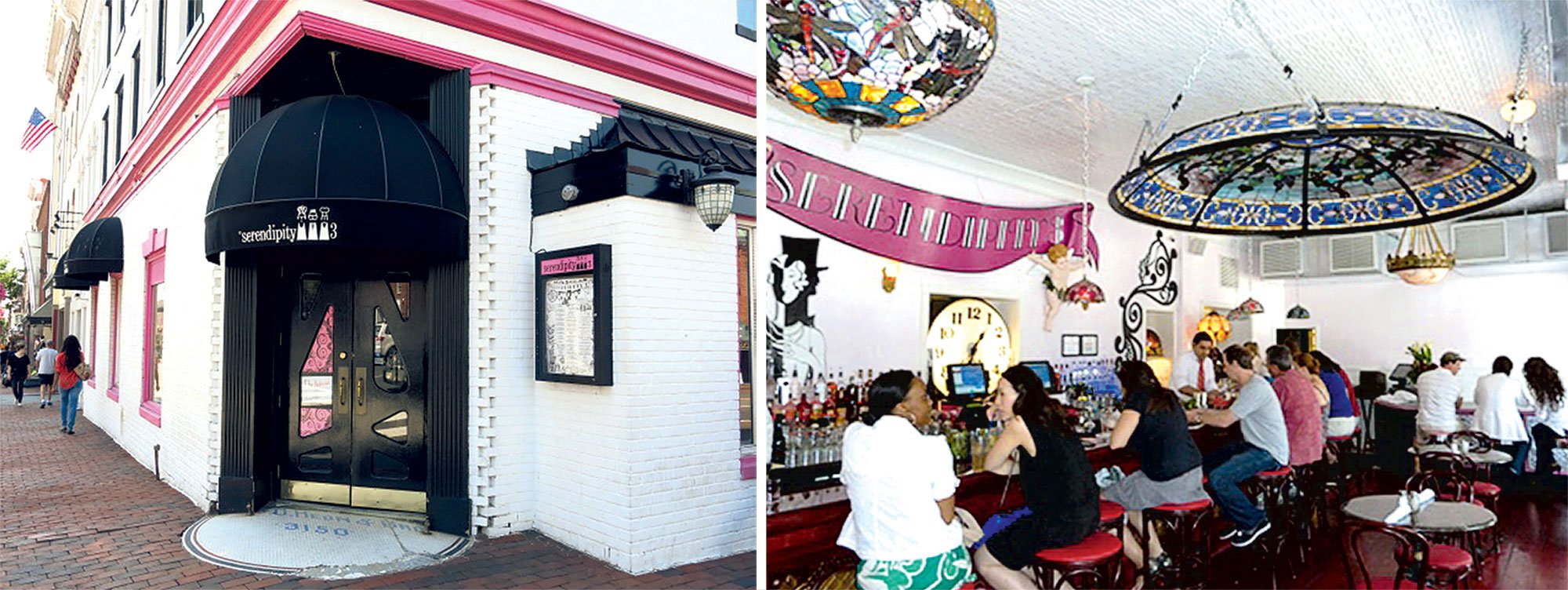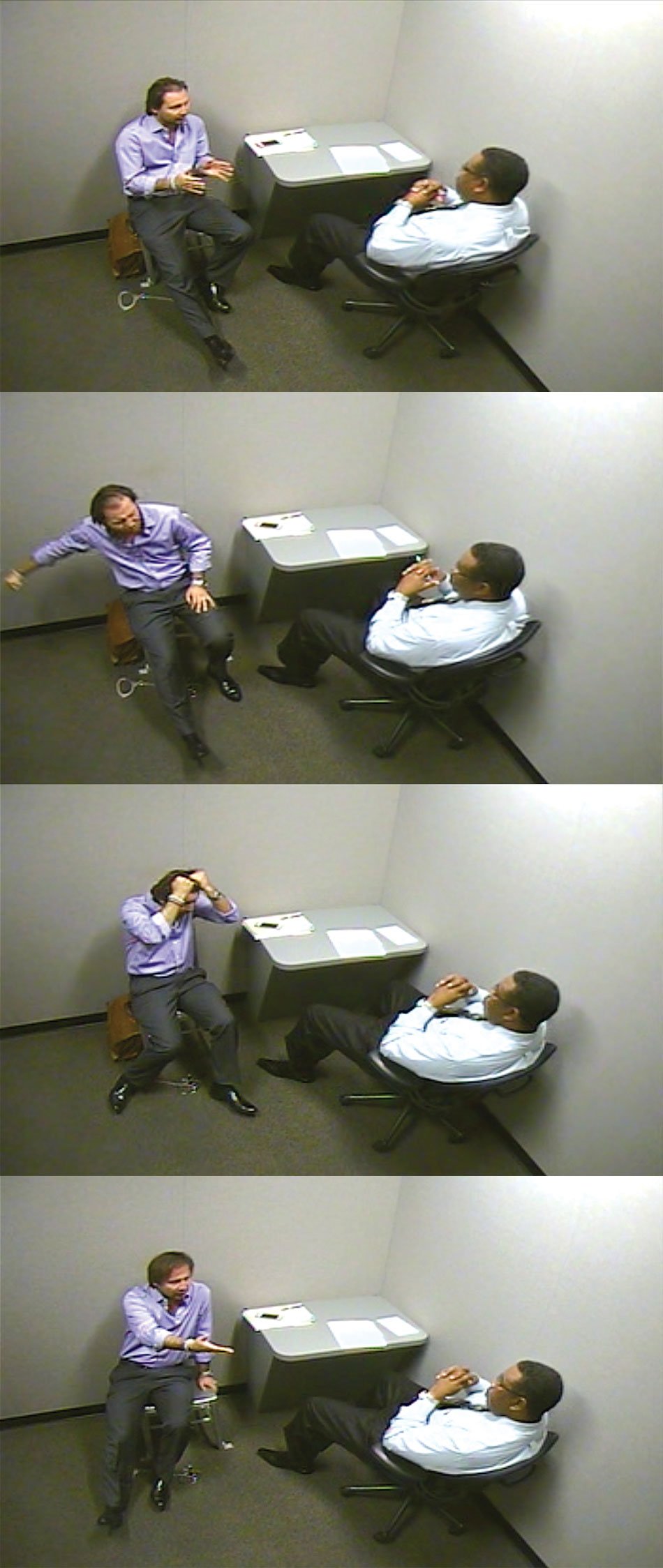Inside the Great Ice Cream Parlor War
Fistfights. Lawsuits. $1,000 sundaes.
The meltdown of Washington’s Serendipity 3 had them all.
By Emily Codik | Opening photograph by Jeff Elkins


(Left) Exterior of Serendipity courtesy of Prince of Petworth/PoPville.com; (Right) Serendipity's interior courtesy of Judith Beermann/The Georgetown Dish.
The 911 call from the Georgetown ice-cream parlor came at 7:18 pm.
“I need the police!” a man pleaded. “We’re having someone vandal [sic] our equipment right now and destroying our security system. . . . He’s drunk, and he’s destroying the business!”
It was a muggy Saturday night in August, and customers were inside the restaurant, indulging in treats like mochaccino milkshakes and banana splits—apparently unaware of what was going on in the basement.
Listen to the 911 Call
“I need him to be removed now!” the man screamed.
The dispatcher needed the caller to slow down, take it from the beginning. Where was he exactly?
“Serendipity!” the man hollered. “The corner of Wisconsin and M.”
Serendipity 3 was not the sort of place usually targeted by vandals. Located on the most heavily trafficked commercial corner in Georgetown, the pink-walled restaurant specialized in desserts like its trademarked Frrrozen Hot Chocolate and deep-fried Oreos topped with inordinate amounts of whipped cream. It was perhaps best known for the trademarked Golden Opulence Sundae: a garish $1,000 sundae crowned with caviar and 23-karat edible gold—the sort of thing likely to generate a lot more media attention than actual sales.
What hadn’t been getting media attention, though, was the long buildup to this particular evening, August 31, 2013. The man screaming into the phone at 911 was Rodrigo Garcia, co-owner of Serendipity. And his alleged vandal was no stranger. The supposed perp, in fact, was Garcia’s business partner: the other owner, Britt Swan.
The fight ostensibly had to do with the restaurant’s surveillance system. In reality, it was about which man—Garcia, the slick son of a notorious socialite, or Swan, the low-profile owner of several Washington watering holes—would wrest control of Serendipity.
Garcia had recently sent video clips to Serendipity’s investors, claiming they showed his allegedly intoxicated partner filching paperwork from the business. Swan believed the clips were doctored, and he had shown up looking for the original footage. The only way to clear his name, he’d thought.
Garcia was not happy.
“You’re destroying the system!” he hollered at Swan as he kept 911 on the line. “Leave it alone!”
“Back away,” Swan said calmly.
Garcia’s shouting became louder and louder.
“No!” he yelled. “It’s mine. It belongs to the business.”
“I am the business,” Swan answered.
“I am, too! You motherf---er! You piece of shit!” Garcia shouted. Then he made a move that would become the most decisive moment of the pair’s tumultuous, four-year relationship: He dropped the phone and advanced toward his partner.
“You want me? You got me!” Swan bellowed.
“You’re finished!” Garcia warned.
On and on they went—all while the 911 operator continued to listen and record every second of the four-minute call.
Swan left before the police arrived, and the men never settled their dispute that night. It would end up spiraling into several voluminous lawsuits, allegations of alcohol abuse, and a marital split. Within a matter of months, Serendipity would be bankrupt and shuttered, and titillated Georgetowners would find themselves marveling over the most spectacular Washington restaurant implosion in recent memory. How in the world, they would ask themselves, did an ice-cream shop known for gold-enrobed sundaes descend into chaos?

In the beginning, Garcia and Swan partied together.
“New Year’s with the Georgetown babes!” Swan’s girlfriend wrote in a Facebook post capturing the pair on New Year’s Day in 2010. There was more than a new year to celebrate. Although they hardly knew each other, Garcia and Swan were gearing up to go into business together.
It had all started almost by chance a few months before, when Swan began dropping by L2, a Georgetown lounge in Cady’s Alley. Graying and bespectacled, Swan owns the nearby college dive, Rhino Bar & Pumphouse and has investments in other like-minded establishments, including downtown DC’s Sign of the Whale and the San Antonio branch of Coyote Ugly, the national chain known for scantily clad bartenders who dance on bar tops. Garcia, dark-haired and confident, was managing L2, a basement hideaway for yuppies and Euros looking to steer clear of beer-chugging kids—like the ones at Swan’s Rhino Bar.
The men clicked over their shared interest in the nightlife business. They were also both coming off setbacks.
Swan had exported a version of the DC nightclub Fly Lounge to Aspen, but it struggled amid a limping economy and noise complaints from neighbors. Garcia, for his part, had been in talks to become an investor in a club, but the deal fell through. One night, he confided this disappointment to Swan, who was at that moment hatching plans for his next venture.
“Would you be interested in partnering up and doing something?” Swan asked Garcia, according to a statement Garcia later gave police.
Swan had recently been approached about taking over one of Georgetown’s busiest corners: Wisconsin and M. Steps away from Banana Republic and Benetton, the property had housed the popular neighborhood haunt Nathan’s for 40 years. Swan had a line on the place, and he was in the market for a partner.
In Garcia, he couldn’t have found someone more different.
Tanned with slicked-back hair, Garcia, who is 43, has a manicured look; chest hair sometimes peeks out from his shirt. He speaks quickly, airing thoughts impulsively. Swan, who’s 65, has tousled hair and a bushy gray mustache. He endows normal interactions with great formality, often referring to people he knows well as Mr. or Mrs.
Swan shied away from publicity. Garcia, by contrast, came from a family who lived in the headlines. His mother, Bolivian-born Marlena Cooke, married Washington’s most famous sports billionaire, former Redskins owner Jack Kent Cooke, in 1990, just a few years after she pleaded guilty to a federal charge of conspiracy to import cocaine. Marlena was decades Jack’s junior, and their union roiled the tabloids. Especially the time police arrested her on a drunk-driving charge for racing down M Street in Georgetown—just feet from the future location of Serendipity—with her twentysomething paramour clinging to the hood of her Jaguar.

Photograph by Cecilie Olaussen/Washington Life.
Garcia spent his early twenties living at his new stepfather’s $2-million mansion, Marbella, according to Dancing With the Devil, a takedown that Cat Crozier, Jack Kent Cooke’s executive assistant, published in 2011. Garcia “had no job, no hobbies to speak of and would sleep away the entire day if he could get away with it,” Crozier wrote. Garcia’s lawyer declined to comment for this story.
Despite their differences, Swan and Garcia each had something the other needed. Swan was the guy with experience—more than 20 years of it. Garcia was the one with the right connections. Married to Erika Gutierrez, a young PR executive whose father had served as Commerce Secretary in the second George W. Bush administration, he and his wife were fixtures on DC’s party circuit, constantly photographed at socialite-studded events like the Virginia Gold Cup and the Meridian Ball. “He knows everybody,” says Paul Guzzardo, owner of L2 Lounge.
The plan was simple: Open a DC franchise of Serendipity 3, a hugely successful New York restaurant that also has locations on South Beach’s Lincoln Road and the Vegas Strip. Swan had been approached by a licensor and was keen on the concept. So he and Garcia began taking trips to New York.
They were quickly sold. The cuisine was deeply American, featuring chicken fingers, hamburgers, red-velvet cakes, cookie-dough ice-cream sundaes, and treats galore. It was kitschy—with Tiffany lamps, gold mirrors, bistro chairs. And the chain had a celebrity-studded story.
The original Serendipity 3 had launched in 1954 as a four-table bistro on the Upper East Side. After luring Andy Warhol, Marilyn Monroe, and Jacqueline Kennedy as regulars, it became a must-see for legions of tourists. It was also immortalized in the 2001 rom-com Serendipity, with John Cusack and Kate Beckinsale. “Part of what attracted us to the brand was that at 9 am there was a line out the door,” Garcia says of the New York location.
Garcia and Swan imagined those same swarms in Georgetown. This was, after all, the neighborhood that birthed Sweetgreen and Georgetown Cupcake. Serendipity “is like a Cheesecake Factory on steroids,” Garcia says. “It fit perfectly with that corner, and if you look at it, with the very tchotchke look, Georgetown has those same saloons.”
By March of 2010, Garcia and Swan had signed a 62-month lease, worth more than $1 million, with monthly rent for the old Nathan’s space starting at $18,000. To pay this princely sum, the partners had a plan to peddle more than $9 milkshakes. They would design a bar where patrons could sip “Gummy Bear martinis” and other cocktails while their kids sampled burgers and shakes. Alcohol, not ice cream, would float their new business. As Garcia puts it, “We thought we had a home run.”

Serendipity finally debuted 15 months later.
On opening day—Memorial Day weekend, 2011—Garcia and Swan mugged for the cameras holding giant sundaes, grins plastered across their faces.
There was good reason to smile. For some weeks after its opening, the restaurant had hourlong waits for tables. As Judith Beermann wrote on the Georgetown Dish website, guests “enjoyed lunch as if they’ve been coming here for years.”
Away from the gaze of guests, however, it was a different story. The partners began to “butt heads” almost immediately after signing their lease, Garcia later told police. One of their earliest problems centered on something both basic and critical: negotiating how the company would be set up and operated.
Swan wanted to head up the day-to-day operations, overseeing staffing, purchasing, and service. He saw Garcia focusing on PR, marketing, and private events: acting as the public face of Serendipity. “[I have] opened numerous hospitality locations and [have] a good reputation,” Swan e-mailed an attorney at the time. “This restaurant and investment opportunity needs ONE person with the final say-so.”
Garcia didn’t like that idea—and didn’t think running Rhino Bar qualified Swan for the task. “It’s not rocket science to own and run that,” Garcia later told police. “He’s not sophisticated enough to be a restaurateur. Between a college bar and a restaurant, it’s night and day.”
After months of haggling, Swan and Garcia finally signed the paperwork establishing their partnership. Swan did so thinking he was in charge. Only later did he realize that wasn’t the case. Edited into the final draft was a change he hadn’t noticed at the time: It gave the partners equal authority over day-to-day operations at Serendipity. The arrangement meant future disagreements would be a nightmare to settle. If irreconcilable problems arose, Swan and Garcia would have no choice but to appeal to Serendipity’s investors. And the final interest structure—42.5 percent for Swan, 32.5 percent for Garcia, 10 percent for Garcia’s mother, 5 percent for Garcia’s brother, and the remaining 10 percent split between a friend of Garcia’s and an acquaintance of Swan’s—would create an environment where investors had to pick sides.
The agreement also made it nearly impossible for either Garcia or Swan to force the other out. “In the event of any serious disagreements . . . termination of a manager was very difficult,” Garcia said in an affidavit. “It would be messy to split up the business.”
There was one way, however. Tucked inside the 25-page document was a brief clause that would become pivotal in the future: It stated that if convicted of a felony, a partner could be removed from the company.
Days after the restaurant’s opening, Garcia and Swan had a blowup.
They started arguing during the installation of a safe—a confrontation that may have been a proxy for other issues: The partners had hit significant delays while negotiating the paperwork for Serendipity, meaning they’d been paying rent on an unopened restaurant. The ice-cream parlor was $300,000 in the hole when it finally started serving, and each partner had complaints about the other.
Swan said Garcia was showing up 30 minutes late to meetings and “could not produce the contacts that he said he had,” according to a letter Swan sent investors. Garcia had his own issues. Swan had been in charge of construction, an arrangement that, Garcia later told police, was “a big mistake,” because Swan, he claimed, cut corners that led to repairs down the road.
But even for a pair so accustomed to discord, the confrontation during the installation of the safe took a new—physical—turn. Their shouting, according to court records, devolved into a “tugging” match.
The partners began communicating through passive-aggressive e-mails about matters big and small. Swan condescended to Garcia like an exasperated father; Garcia reacted with the scorn of an impetuous son. “You have all documents [sic] learn how to look into your email,” Garcia wrote Swan, in reference to a legal bill. “I thought your [sic] the experienced guy here.”
“To have to ask so many times for these records from you . . . is well—strange,” Swan replied.

Video stills courtesy of Metropolitan Police Department.
Stranger still was that in the middle of all their bickering, Garcia filed a police report about the fight—a full three months after it happened. Garcia said Swan “jumped up from his chair, grabbed [Garcia] by the neck and slammed him into a desk and the wall,” according to police records from September 2011.
The odd thing is that Swan—who later characterized the fight as a “pushing incident”—had no idea his partner had gone to the cops. (It would take a whole year for them to arrest him on a misdemeanor charge of assault.)
Several months later, in May of 2012, with police having done nothing about his report, Garcia went to the cops again about another fight. On this particular night, Swan got a text message from a Serendipity manager who said Garcia was upset and shouting about the staff. Swan says he went to the ice-cream parlor to see what was going on, and they got into it.
In Garcia’s version, Swan threatened him. “I have more money, more investments than you here. Do you want me to kill you?” Swan said, according to Garcia’s statement to police. Swan then punched him in the forehead, Garcia told police.
In Swan’s telling, the night unfolded differently. Garcia came toward him, so he pushed Garcia back, and from there, according to a response Swan filed in court, the two got into another “pushing incident.”
Swan—who, before he met Garcia, had a clean criminal record in DC—was charged with simple assault, a misdemeanor. Police also booked him for the kind of charge that, if he was convicted of it, could have cost Swan his partnership in Serendipity: felony threat.
Garcia went further. He asked a judge to give him a restraining order against Swan, claiming his partner was out to get him. “[Swan] has tried to kill me once,” Garcia alleged. “I’m afraid that I might not be so lucky next time.”
The judge went ahead and granted the restraining order—which gave rise to a very peculiar work environment. The partners suddenly had to jostle their schedules to avoid each other: Swan could be at Serendipity only till 5 pm, while Garcia was allowed on premises only at night.
Garcia avoided the upstairs office and worked exclusively from the basement. He started dispatching erratic e-mails, accusing Swan of buying favors and misappropriating company funds. “Soon you won’t be able to hide all that you have done to mislead all our investors,” Garcia e-mailed Swan and investors in November 2012. “Britt your [sic] on borrowed time guy!!”
To Swan, this was pure “spin doctoring” of the facts. “You fire off emails that you think make you look intelligent, but truth is, your intelligence level is suspect,” Swan replied.
“Never have I seen two owners act like that,” says Mark Walsh, a former Serendipity consultant and a longtime Georgetown insider who worked at Clyde’s back in the 1970s. “They refused to come to an agreement or in any way compromise.”
It was Swan who would end up winning the most important rounds of this fraught period. In the first criminal case, after the fight during the installation of the safe, prosecutors dropped the assault charge in the fall of 2012. In the second criminal case, after the shouting match, prosecutors decided to go after Swan only for the assault misdemeanor, and he was able to secure what’s called a deferred prosecution agreement; in exchange for doing some community service, prosecutors dismissed the charge. Swan held up his end of the deal by cleaning Rock Creek Park’s turtle tank.
Serendipity became like the child caught in a nasty divorce.
When police later asked Garcia why he hadn’t walked away from the business, he said he didn’t have a choice. Both partners had tried to sell their shares to each other, but neither wanted to pay the other’s asking price. Garcia and Swan each had more than $500,000 dollars invested in the restaurant, bankruptcy filings show—nobody was ready to walk away from that kind of money.
Business now transpired almost entirely over e-mail. “You are like the mosquito on an elephant’s butt—just another pest,” Swan wrote once. Garcia sometimes responded with just three words: “Go f--- yourself.”
It didn’t help that the purportedly foolproof business plan had turned out to be severely flawed. There weren’t enough regulars streaming in for the Gummy Bear martinis. After the opening rush slowed, people mainly stopped in for the famous $10 Frrrozen Hot Chocolate, split five or six ways. It may not have been a huge shock that only one customer ever bought the $1,000 sundae, but it was surprising that the place captured so little of its over-the-top hype.
Swan and Garcia tried to entice the happy-hour crowd by running drink specials with half-price mini-burgers, but nothing worked. “People confused us with an ice-cream parlor,” Garcia says. “Alcohol was a huge component to our bottom line, and we just didn’t have the sales.” Desperate, Serendipity imposed a minimum fee: Patrons had to spend at least $10 per person for a table.
Starting a restaurant is never easy. It can be difficult to gauge how customers will respond to a menu or setting. There’s also the issue of staff turnover, a constant challenge in the industry. At Serendipity, the turnover was particularly high. Over three years, at least four general managers quit, some under dramatic circumstances. In an e-mail to Swan, Mark Medley, a former GM who has worked in restaurants for 30-plus years, said Garcia fired him “after a few expletives”; Medley described it as “one of the most unprofessional situations” he had ever encountered.
By July of 2013, Garcia and Swan’s relationship was irreparable. After a stressful argument over a bank account, Swan decided he needed a break from the chaos. He basically disengaged and stopped coming around—a sort of self-imposed exile from the business.
With Swan gone, Garcia sought to turn around the enterprise by offering customers less, employees say. The restaurant lacked sufficient dishware, such as coffee cups and spoons, according to former waiters. “Rodrigo told us, ‘I don’t want to see straws or lemons in water cups,’ ” one says. “He didn’t want to spend one extra dollar.” (Garcia initially granted Washingtonian two interviews, but when approached with follow-up questions, he declined to comment further.)
Even with the cuts, Garcia couldn’t pay his suppliers, and in August of that year, the restaurant’s linen service sent him a letter threatening to sue. Still, he kept trying to generate business. Throughout this time, he trained an assiduous eye on the security cameras, commonly used by restaurants and bars to monitor staff. An employee recalled one slow Saturday when Garcia messaged a manager in a tizzy. He had been spying on the restaurant and wanted to know why the waiters were standing around aimlessly.
“The restaurant was empty,” says Sarah Kranau, a former Serendipity waitress and bartender. “He was like Big Brother, watching the security camera from home all day.”
By then, the restaurant was losing more than money—it had exhausted its political capital, too. Stephen Bruce, founder of the Serendipity brand, was disappointed, and the partners’ investors were exasperated. Every day they were inundated with e-mails enumerating each squabble.
Garcia’s “emails and actions reveal that he is ineffectual and perhaps in a confused state of mind,” Gaurav Singh, one of the investors, wrote to an attorney. “Nor do I feel comfort in knowing that my investment lies in the hands of a tenuous, unqualified and inexperienced managing partner.”
Singh had put money into the venture because he’d been a college roommate of Garcia’s brother and known their family for years. But now that relationship was on the rocks, too. Singh had pulled away from the family, and Garcia felt Swan had turned his friend against him.
The partners’ most explosive fight was ignited by bread invoices.
One Sunday night in August 2013, while he was still out on his self-imposed hiatus from Serendipity, Swan stopped by the place to check on the finances. Among the papers he parsed were a few bills from the bread supplier.
Garcia was outraged when he found out, and he soon sent their investors the infamous security-camera video clip that purportedly showed a drunken Swan removing the invoices from the office.
It was Swan’s turn to get mad. The clip showed him only picking up the bills, not putting them back, which he says he did. And that’s how Swan ended up rumbling down to Serendipity’s basement on the night of August 31 to get the footage himself. How Garcia arrived to find Swan unhooking the DVR and, for the third time, how he tried to get the cops to arrest his partner.
"Never have I seen two owners act like that," says a former Serendipity consultant.
“Back away, you’re drunk! Back away!” Garcia screamed during his hysterical call to 911 that night.
“Don’t touch me,” Swan said calmly. “I’m leaving this room.”
By the time police arrived, Swan was gone.
Hours later, a nuclear bomb of an e-mail went out. It was past midnight, and Garcia’s wife, PR exec Erika Gutierrez, sent it to all four of Serendipity’s investors as well as the licensor. The note was long, impassioned, and strewn with cap locks: “I am sick and tired of being worried for Rodrigo’s life because of that alcoholic Britt. He is a loose cannon and I’ll be damned if the safety of my husband’s life is at jeopardy because of it. This is an extremely serious situation.
“WHAT ABOUT THIS IS OKAY?!?!?! HOW CAN AN ADULT BUSINESS OWNER ACT LIKE THIS??!?!?! . . . I am disgusted by this old man’s behavior. . . . GET HIM THE HELL OUT.”
The following week, Garcia went to the police station no fewer than five times to try to convince police to arrest Swan for assault. On September 5, after much pleading, he was finally granted an audience with a detective. For more than an hour, Garcia sat in an interrogation room, sounding nothing like the frantic caller from a couple of nights before, instead casually tossing off accusations as if catching up with an old friend at a bar.
He said Swan was a “drunk” who had a lot of “white-boy military guys” working at Rhino Bar, according to the taped interview, adding that Swan had contacts in “Special Forces” who could “snap your neck in two seconds” and “make people disappear.”
Then he went even further.
“If it’s a felony charge, it helps me a lot with the business,” Garcia said. It would mean Swan “can be removed.”
This time the charges led to a prosecution.
Five months later, in late January 2014, the partners faced each other in a DC courtroom for the bench trial against Swan.
The prosecutor tried to cast the case as a cut-and-dried assault, but G. Allen Dale, Swan’s lawyer, tried to put the fight in context for the judge. Dale (who, incidentally, had once represented Garcia’s mother, Marlena Cooke, in a federal drug case) walked through the partners’ rocky history, explaining how Swan’s and Garcia’s one-upmanship had doomed their once-promising venture. This was no “typical” assault case, Dale said. It was a complicated case of “pointing fingers” over Serendipity’s looming demise.
To understand that, he went on, all you had to do was hear the tape of the four-minute 911 call. “Listen to the voices,” said Dale, “and you’ll know who’s assaulting who.”
The call is loud and hectic and sounds like reality TV—it starts with Garcia’s hysterics, continues with Swan’s mild-mannered warnings, and ends with a few haymakers.
“You want me? You got me!” Swan shouts.
“Get off of me!” Garcia pleads.
In the end, the trial was quick—open and shut in less than half a day. “It appeared that the animus and the volume and the cursing and yelling was by [Garcia],” the judge said. “It’s quite clear,” he concluded, “what his intentions were.”
Swan was acquitted.
But as you might expect, that wasn’t the end of the trouble.
Two days after clearing his name, Swan was caught driving under the influence; he was later convicted of the misdemeanor in Prince William County. Then in March, Serendipity was sued for $100,421.54 in unpaid rent and fees by its new landlord, Under Armour founder Kevin Plank. The restaurant was soon hit by another lawsuit demanding money, this one filed by its linen service.
In May, Garcia wrote an e-mail to Swan announcing his resignation, effective immediately. Before long, Garcia and Erika Gutierrez revealed that they were divorcing after a year of marriage.
Swan, meanwhile, was left to clean up the mess. With Serendipity $2.3 million in debt, he filed for bankruptcy and closed the place in June. He decided he wanted revenge. Last August, Swan filed a $6.65-million civil suit against Garcia, Gutierrez, and her PR firm. In the complaint, he claims Garcia filed a false police report and committed perjury in the assault case, all to secure a felony conviction against Swan and take full control of Serendipity. Swan claims Garcia and Gutierrez worked together to tarnish his business reputation. They “made slanderous and libelous statements . . . asserting that Swan was mentally unstable, was a drunk, that he was violent,” the complaint states. Swan is also suing Garcia for misappropriating company funds, claiming Garcia “wrongfully obtained” nearly $50,000 of Serendipity investors’ money in 2010.
Both Gutierrez and Garcia are fighting back. Gutierrez countersued Swan for $4 million for emotional distress, claiming “Swan intentionally and maliciously assaulted, battered, and/or struck” Garcia and that this led to the breakdown of her marriage. Garcia has denied the allegations and has filed a motion to dismiss the lawsuit. All sides continue to point fingers, and there are whispers of more litigation to come.
Even former employees didn’t escape Serendipity unscathed. Last spring, the home of the $1,000 ice-cream sundae issued a former bartender her final paycheck. It was for 55 cents. The check bounced.
Emily Codik is an editorial fellow at Washingtonian and can be reached on email at [email protected] or on Twitter at @emilycodik.
This article appears in the March 2015 issue of Washingtonian.